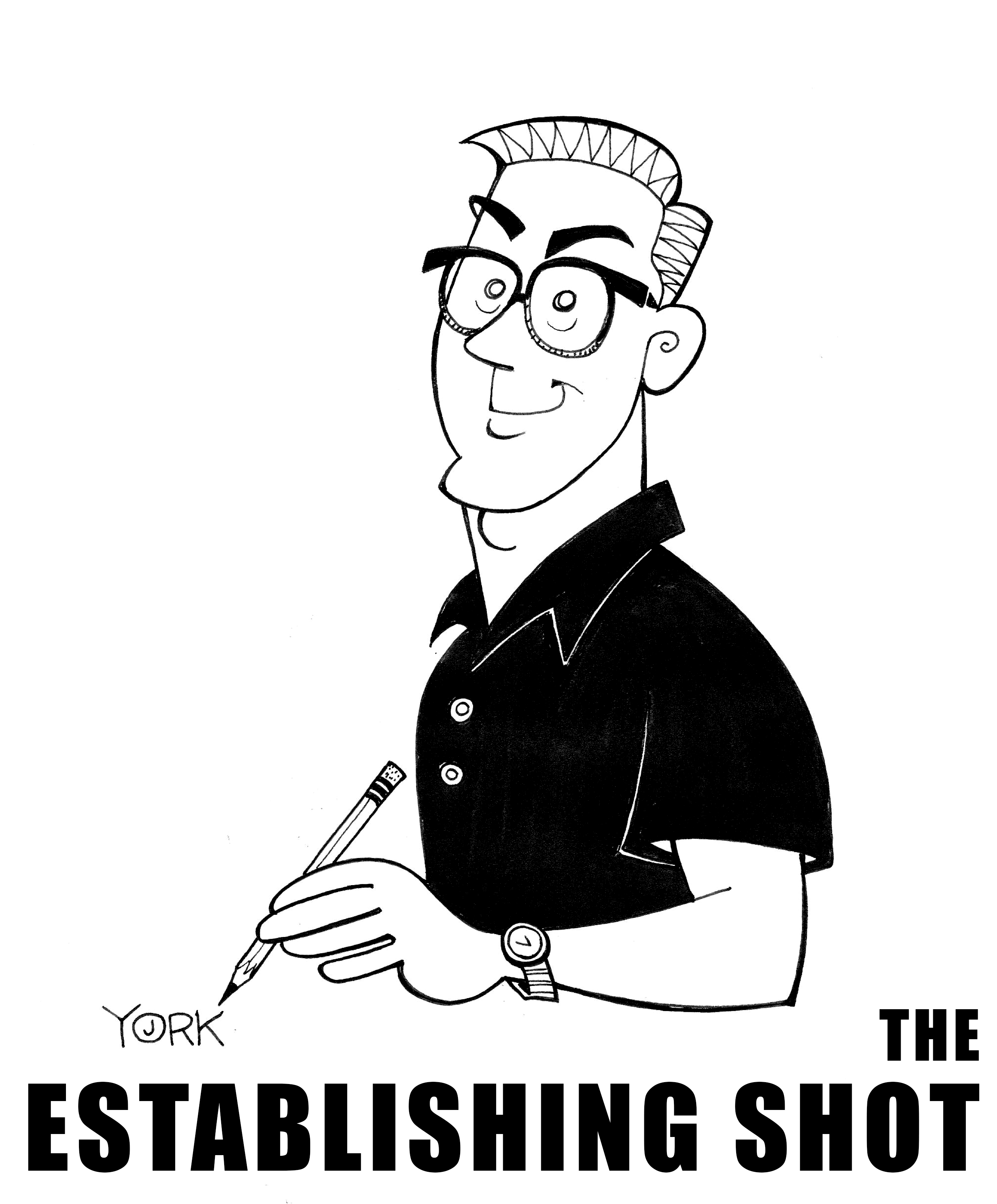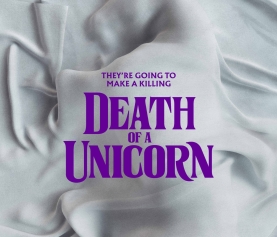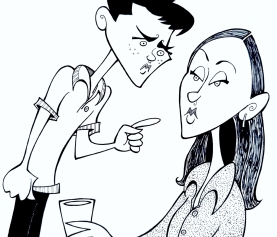
Original caricature by Jeff York of David Gale and Jeffrey Combs in RE-ANIMATOR (copyright 2020)
With the passing of filmmaker Stuart Gordon this past week, I was inspired to re-visit his darkly comic horror film RE-ANIMATOR. A loose adaptation of H. P. Lovecraft’s horror short Herbert West – Reanimator, Gordon made it his own by amping up the comedy and the grotesque in equal measures for a modern horror classic. When it came out in 1985, America was settling into a comfortable groove with a second term of the Reagan administration, a nationwide obsession with music videos on MTV, and a steadying economy. Gordon likely wanted to shake audiences out of its complacency, and he did just that with his hellzapoppin horror show.
The film was probably too controversial by half to be anything more than a qualified hit at the time, but nonetheless it still had quite an impact. Not only did it achieve instant cult status, and lead to a number of sequels, but it cemented Gordon’s artistic reputation as a provocateur and set his film career up to continue to shock and awe. (He’d already done a lot of similar things in Chicago with his Organic Theater Company where, among other things, he introduced the world to the equally edgy playwright David Mamet when he produced his first play entitled Sexual Perversity in Chicago.) 35 years later, the chills and laughs Gordon put out for the world to see in RE-ANIMATOR still stand tall, and if anything, the entire enterprise seems even more outrageous than it did when it opened during that comfy and conservative Reagan era.
The idea of reanimating corpses wasn’t exactly the edgiest subject for the horror genre. Mary Shelley’s Frankenstein, which helped start the genre back in 1818, was about that very idea. Nor was excessive violence and gore new to films or even TV shows in the genre. The Hammer horror films dumped buckets of blood all over the screen in the ’60s. THE NIGHT STALKER made-for-TV movie in 1972 pushed the boundaries of violence transmitting into people’s homes with its tale of a vampire on the loose in Las Vegas. And God knows that John Carpenter was raked over the coals by critics for the spectacularly graphic deaths in his remake of THE THING in 1982. RE-ANIMATOR didn’t do anything all that new by being excessively violent. What was novel about it was how viciously it was employed, and how glibly. It was gross, sure, but mostly, it was served with a sense of humor.
In a word, RE-ANIMATOR was nasty.
Nasty in tone, look, and physicality, not to mention its treatment of death, the medical community, patriarchal society, ingenues, and yes, the classic hero’s journey. It was a sniggering and snide middle finger to propriety, daring audiences to watch, laugh, and stay till the end of a film wall-to-wall with outrage. Some did, some didn’t. I had to chase after my date who walked out during it due to being so offended. I returned the next day to see it on my own. It was a very polarizing movie.
The story concerned a brilliant but certifiably cuckoo medical student named Herbert West (Jeffrey Combs) who has invented a reagent that can re-animate deceased bodies. He pulls his classmate and roommate Dan Cain (Bruce Abbott) into his twisted world when cat Rufus ends up dead by accident and West brings it back to life with his DayGlo green goop. Unfortunately, the lovable personality of the frisky feline doesn’t return as easily as his body. Instead, the sweet kitty’s personality is replaced by a savage and mutated one, a zombie-cat driven by bloodlust. As the two roomies dig deeper into experimentation with reanimation, human bodies start to pile up all over campus, all becoming as vicious as poor Rufus. It’s a film with a pretty sizable body count, one that ends with most of the cast dead, or at least dead for the moment. Dr. West’s formula glows in the dark in the final fade to black.
Combs gave one of the greatest horror film performances ever, a snide sociopath somewhere between Tony Perkins’ boyishness and Christopher Lee’s silken menace. West was arrogant, tart-tongued, and incapable of even showing a speck of human empathy, By the end, he’s not become a better person one iota. Instead, he’s grown even more obsessed and dangerous. And he’s the lead. (Gordon was all but taunting Joseph Campbell, if not Robert McKee.)
Dan, while a cliched handsome hero in appearance, is little more than a feckless fool throughout. West all but leads him by the nose the entire time. Dan’s girlfriend Megan (Barbara Crampton) is introduced as a sweet, innocent girl and then promptly gets pulled into one humiliation after another. She’s bamboozled by Dan, has to watch her kind father, the dean of the school (Robert Samson), die and then turn into a vicious zombie. West treats her with derision, and the film’s villain Dr. Carl Hill (David Gale) will spend the entire hour and 45-minute running time trying to get into her pants. Today, they’d give her a Katniss Everdeen moment or two to counter such victimhood, but not in ’85.
RE-ANIMATOR is a film that at every beat of its story, exuded in its politically incorr ect attitude Gordon, and his fellow screenwriters Dennis Paoli and William J. Norris threw all the sacred cows out the window or against the wall. (Literally and figuratively, truly.) Rufus’ death is played for grisly laughs. So are all the human deaths. The story also ridicules people in mental institutions, padded cells, and morgues. The character of Megan’s father goes from a sweet, caring man to a drooling, lobotomized caricature in about 10 minutes. And to justify its adult rating, Megan ends up nude for a great deal of the third act. It should be noted too that the film has no problem lingering on Crampton’s comely figure either, including her pubic region. The film takes no prisoners and laughs all the way to the dank.
Most horror comedies tend to play more cute than cruel, like BEETLEJUICE, GHOSTBUSTERS, and ZOMBIELAND. RE-ANIMATOR, however, emphasizes humor that often plays as mean as the bloodletting. Nowhere is this more evident than in how Gordon treats the film’s villainous Dr. Hill. When West catches him trying to steal his reagent, he attacks him with a shovel, and then for good measure, decapitates him too. Still, Hill stays in the picture. The lascivious villain is reanimated and soon both his head in a pan, as well as his foot shorter body, are plotting more nastiness.
The film ends with a phantasm of violence and craziness, chock full of multiple corpses attacking and spraying blood and guts around like the top was left off of a Cuisinart. Yet, even that over-the-top ending cannot compete with the single most memorable set piece in the film. That is when Dr. Hill’s decapitated head tries to, ahem, give head to Megan as she’s strapped to the slab. (Thankfully, my girlfriend left before that scene!)
When the film was originally presented to the review board, it received an X rating because of such scenes, as well as its violence. Gordon trimmed some bits and pieces here and there to scale back such offenses, and thus ensured the video release of the film got an R rating that made it acceptable for Blockbuster and mom & pop stores nationwide. In rentals is where the film really took off and built its reputation that it enjoys today.
Gordon and his producer Brian Yuzna consciously went for the shock and delivered it in spades. They spent a considerable amount of their meager $900,000 budget on the gruesome makeup effects, ensuring that they were as disgusting and graphic as the photos they discovered in a forensics pathologist manual. John Naulin, the film’s effects supervisor, said it was the bloodiest film he had ever worked on. In past horror films, he never used more than two gallons of blood. For RE-ANIMATOR, he used 24.
And, dare one say, it was bloody effective. By not pulling its punches, RE-ANIMATOR was true to Gordon’s vision of splitting skulls and being side-splitting too. And for such a brazen film, it’s got dozens of quotable quips, particularly those uttered by West. When he discovers the headless Hill trying to get it on with Megan, West admonishes the bad doctor. “I must say, Dr. Hill, I’m very disappointed in you. You steal the secret of life and death, and here you are trysting with a bubble-headed coed.” Snark like that is comedy gold. And it’s in a horror film.
It’s not everyone’s cup of tea, but then Gordon wasn’t interested in the status quo.







